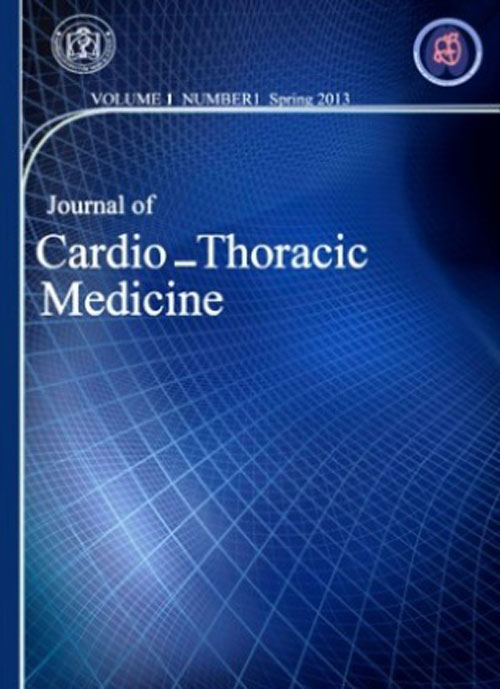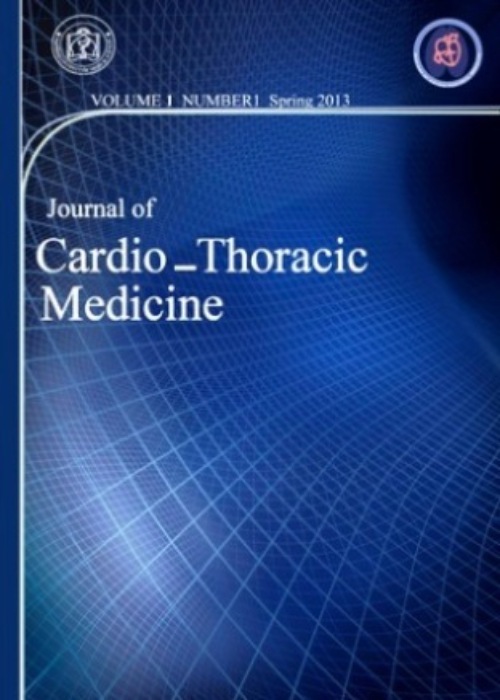فهرست مطالب

Journal of Cardio -Thoracic Medicine
Volume:4 Issue: 2, Spring 2016
- تاریخ انتشار: 1395/03/30
- تعداد عناوین: 8
-
-
Pages 423-436Transcatheter aortic valve replacement (TAVR) is a novel therapeutic intervention for the replacement of severely stenotic aortic valves in high-risk patients for standard surgical procedures. Since the initial PARTNER trial results, use of TAVR has been on the rise each year. New delivery methods and different valves have been developed and modified in order to promote the minimally invasive procedure and reduce common complications, such as stroke. This review article focuses on the current data on the indications, risks, benefits, and future directions of TAVR.
Recently, TAVR has been considered as a standard-of-care procedure. While this technique is used frequently in high-risk surgical candidates, studies have been focusing on the application of this method for younger patients with lower surgical risk. Moreover, several studies have proposed promising results regarding the use of valve-in-valve technique or the procedure in which the valve is placed within a previously implemented bioprosthetic valve. However, ischemic strokes and paravalvular leak remain a matter of debate in these surgeries. New methods and devices have been developed to reduce the incidence of post-procedural stroke. While the third generation of TAVR valves (i.e., Edwards Sapien 3 and Medtronic Evolut R) addresses the issue of paravalvular leak structurally, results on their efficacy in reducing the risk of paravalvular leak are yet to be obtained. Furthermore, TAVR enters the field of hybrid methods in the treatment of cardiac issues via both surgical and catheter-based approaches. Finally, while TAVR is primarily performed on cases with aortic stenosis, new valves and methods have been proposed regarding the application of this technique in aortic regurgitation, as well as other aortic pathologies.
TAVR is a suitable therapeutic approach for the treatment of aortic stenosis in high-risk patients. Considering the promising results in the current patient population, recent studies have been conducted to evaluate the efficacy of this approach as a standard-of-care procedure.Keywords: Aortic Valve Replacement, Cardiac Intervention, Patient Safety, Percutaneous Aortic Valve -
Pages 437-439IntroductionLimited data are available on the relationship between nutritional status and tuberculosis. The aim of this study was to evaluate and compare the body mass index (BMI) and serum albumin level in patients with active tuberculosis (ATB) and latent tuberculosis (LTB).Materials And MethodsA cross-sectional study was conducted on 17 patients newly diagnosed with pulmonary TB who were referred in Iran, during September 2011 to March 2012 and 17 latent tuberculosis infection individuals. Standard method was performed to collect an early morning fasting blood sample for albumin (by the bromocresolgreen method). Also (BMI) was calculated as body weight divided by height squared (kg/m2).ResultsOne-sample Kolmogorov-Smirnov test was used to check normal distribution data The mean ± Standard deviation(SD) for albumin in the patients and controls were 3.62±0/56 and 4.68±0.25, respectively. BMI in the patients and controls were 19.46±2.79 and 25.4±3.46, respectively. The serum albumin level was significantly lower in the patient group, compared to the control group (PConclusionOur findings demonstrated that BMI and serum Albumin were significantly lower in the active tuberculosis patients than latent tuberculosis groups.Keywords: Albumin, Body mass index, Tuberculosis
-
Pages 440-443IntroductionLung cancer is one of the leading causes of cancer related deaths in the world. The incidence of lung cancer is increasing in India and there is a need to understand the natural history of this disease.
Aim of the study: To study the clinico- pathological- radiological profile of patients diagnosed with lung cancer from January 2013 to May 2015 at a tertiary care teaching hospital.Materials And MethodsInpatient records of all patients admitted during the study period were examined and all patients with a histologically proven diagnosis of bronchogenic carcinoma were recruited. Demographic characteristics, clinical, radiological and pathological details of each patient were recorded.ResultsFifty four patients with lung cancer were identified. Forty three (79.6%) were male and 11 (20.4%) were female. Thirty two (59.7%) were smokers and 22 (40.7%) were non smokers. Cough and expectoration (61.1%) was the most common presenting symptom followed by breathlessness (59.3%). Mass lesion (81.5%) was the most common radiological presentation and adenocarcinoma (42.6%) was the most common histological subtype. When compared to fiber optic bronchoscopy, image guided percutaneous biopsy had a better yield for diagnosing lung cancer (51.9% vs 48.1%). But this difference was not statistically significant (p=0.892)ConclusionAdenocarcinoma is replacing squamous cell carcinoma as the most common type of lung cancer in India.Keywords: Adenocarcinoma, Image Guided Biopsy, Lung Cancer -
Pages 444-449IntroductionPsychological symptoms of non-cardiac chest pain (NCCP) including perceptual, emotional, and behavioral problems can effect patient perception of chest pain. This study was conducted to determine the effect of metaphor therapy on mitigating depression, anxiety, stress, and pain discomfort in patients with NCCP.Materials And MethodsThis randomized, controlled, trial was conducted on 28 participants, who had visited the emergency department of Kermanshah Imam Ali Heart Hospital because of experiencing NCCP during the June to September 2014. The patients were randomly assigned to metaphor therapy and control groups (n=14 for each group) during a four-week period. Our data collection questionnaires included Pain Discomfort Scale (PDS) and Depression, Anxiety and Stress Scale (DASS). Chi-square and MANCOVA tests were run, using SPSS version 20.ResultsTwenty patients (71.4%) completed the trial period until the final assessment. Our findings showed that metaphor therapy couldnt lower depression, anxiety, stress, and pain discomfort; In fact, there was not a significant difference between the metaphor therapy and control groups regarding the aforementioned variables (P>0.05).ConclusionsAlthough the study results did not support the effectiveness of metaphor therapy for NCCP, further studies on the potential role of metaphor therapy in attenuating NCCP symptoms seem to be necessary.Keywords: Metaphor Therapy, Non, Cardiac Chest Pain, Pain Discomfort, Psychological Symptoms
-
Pages 450-455IntroductionHeart failure is a major hazard for public health. Despite recent advance in medical therapy, there is not enough information on the outcome of off-pump coronary artery bypass (OPCAB) and medical therapy on the patients with severe ventricular dysfunction and triple-vessel (CAD). This study aimed to compare treatment outcomes and mortality rate in patients undergoing off-pump coronary artery bypass (OPCAB) surgery and medical therapy who presented with severe ventricular dysfunction and triple-vessel coronary artery disease (CAD).Materials And MethodsThis retrospective cohort study was conducted on patients with severe ventricular dysfunction and triple-vessel CAD during 2010-2011 in the Imam Ali Hospital of Kermanshah University of Medical Science. Patients were divided into two groups of medical therapy (group one) and OPCAB (group two). Follow-up data were collected after 30 months. Survival estimation was performed using Kaplan-Meier survival analysis and Cox regression model.ResultsOf the 276 enrolled patients, 139(50.4%) underwent group one and 137(49.6%) group two. Study groups were homogenous in baseline characteristics, with the exception of hyperlipidemia (P=0.005). A significant difference was observed in cardiac mortality rates between the study groups (hazard ratio: 0.260; 95% confidence interval: 0.105-0.644; P=0.004). However, no significant difference was observed between the groups regarding the frequency of admission due to decompensate heart failure (P=0.17). In addition, the rate of admission due to acute coronary syndrome (ACS) in the first group was higher than the second group, significantly (P=0.001). Level of ejection fraction (EF) had a significant increase after coronary artery bypass graft (CABG) (28.50) compared to the preoperative stage (27.59) (P=0.042). However, no significant increase in the level of EF was observed in the first group before and after medical therapy (27.28 and 27.20, respectively) (P=0.83).ConclusionAccording to the results of this study, the mortality rate associated with OPCAB was lower compared to medical therapy, ACS and EF enhancement in patients with triple-vessel CAD and severe ventricular dysfunction.Keywords: Coronary Artery Disease, Medical Therapy, Off, Pump Coronary Artery Bypass Graft
-
Pages 456-460Thoracobiliary fistula is a rare complication of hydatid cyst of the liver especially in the calcified form. Surgery is the only medical option. The treatment consists of radical surgical procedures in the majority of the patients. Conservative surgical treatments are performed with high mortality rate. Herein, we will describe two patients of calcified hydatid cysts of the liver whose condition becomes complicated with Thoracobiliary fistula.
The first patient was treated with right thoracotomy and resection of pleural hydatid cysts. Then, were evacuated the ruptured laminated membrane and daughter cysts of infected hepatic hydatid cysts through diaphragmatic opening and sub diaphragmatic drainage of the calcified liver hydatid cyst. The second patient was also treated with right thoracotomy, resection of pulmonary hydatid cysts, evacuation of ruptured bile stained laminated membrane and daughter cysts of hepatic hydatid cysts through diaphragmatic opening and sub diaphragmatic drainage of the calcified cyst cavity.
Our patients underwent conservative surgery which posed a severe risk. Both cases are discussed together with review of the literature.Keywords: Calcification, Hydatid Cyst, Liver, Thoracobiliary Fistula -
Pages 461-463Aortic dissection occurs when a tear develops in the wall of the aorta, which is rare in the young population. This fatal disorder is hard to diagnose, especially in young patients. We present the case of aortic dissection in a 15-year-old boy referred to the Emergency Department of Yazd University of Medical Sciences in November 2015. The patient presented to our department with sudden acute chest pain. Emergent computed tomography (CT) scanning of the brain, chest, and abdomen reflected bilateral pleural effusion, biluminal aorta, arterial flap in the upper part of the abdominal aorta, and dilated small bowl loop. The patient did not have any aortic dissection risk factors such as history of connective tissue disease, congenital heart disease, coarctation of the aorta, and hypertension. The only noticeable point in the patients history was swimming two hours before the onset of the chest pain. Aortic dissection is a rare differential diagnosis in children with acute sudden chest pain.Keywords: Aortic Dissection, Risk factors, Young Adults
-
Pages 464-464Herein, we present the case of a 45-years-old woman with a foreign body (dental prosthesis) ingestion lodged in the esophagus(Figure.1). The foreign body was extracted by rigid esophagoscopy after severe manipulation. In 24 hours, the patient became febrile with emphysema in the neck. laboratory data showed leukocytosis and CT scan revealed signs of esophageal perforation(Figure.2). Surgical exploration and drainage of the neck and mediastinum performed through a collar incision in the neck extended to the anterior of SCM in both sides, but we didnt perform feeding jejunostomy. We inserted one corrugated drain in every side of the neck(Figure.3).Patient was NPO for two weeks and brief total parenteral nutrition (TPN) provided her calory.Finally,we succeeded to fistulized the perforation to the skin and control the mediastinitis(Figure.4).Patient regained oral feeding gradually after two weeks NPO. The follow-up esophagogram revealed the passage of the contrast to the distal esophagus with no leak and fistula.Early recognition of perforation could interrupt major operation to control catastrophic complication.Keywords: Esophageal Perforation, Esophagoscopy, Foreign Body


